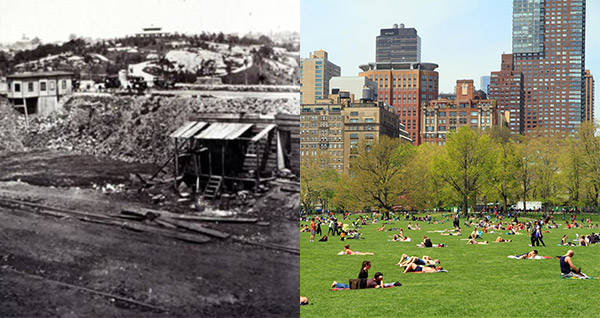

Good Morning POU! Today’s post is courtesy of CBS News, from a segment in 2022.
Uncovering the history of Seneca Village in New York City
Most people who walk through Central Park, from tourists to lifelong New Yorkers, have no idea of the history under their feet.

In 1825, a 25-year-old African American shoe shiner named Andrew Williams bought land in the middle of Manhattan, two years before slavery was abolished in New York. More free Black Americans followed, fleeing the disease and discrimination of downtown, and together they created a bustling settlement of their own, known as Seneca Village.
“Seneca Village was a place of opportunity. It was a reaction to racism,” said Cynthia Copeland, president of the Institute for the Exploration of Seneca Village History. She has spent decades uncovering its story.
Correspondent Faith Salie asked, “There’s a chance that Seneca Village was part of the Underground Railroad?”
“There is, and it’s speculative, but highly probable,” Copeland replied. “Why do you think the history has been untold and unknown until relatively recently?”
“The victorious are the ones who get to write the stories,” said Copeland. “These were people who were forgotten. And it is unfortunate that the story was hidden for so long. But it’s great that the story has emerged.”

Above, A 19th century map showing the settlement of Seneca Village, on Manhattan’s West Side in the 80s, before the construction of Central Park wiped it away. CBS NEWS
Much of the story is an enduring mystery, but an archaeological dig unearthed hundreds of artifacts from the villagers’ middle-class lives.
“We found lots of beautiful bottles, [and] a shoe that was probably the size that was used by one of the children,” said Copeland. “And one of the students just started to cry.”
Seneca Village was home to the largest number of African-American property owners in New York before the Civil War, and because those Black men possessed property, they had the ability to vote. Irish and German immigrants moved in, too, and White and Black villagers attended church side-by-side.
But when New York City elites wanted to create a park that rivaled those of Europe, they were drawn to the middle of Manhattan.
Copeland said, “There was a smear campaign that was created in the media: ‘We’ve gotta get rid of all those people that live in the park that shouldn’t be there. They are tramps, squatters, and thieves.’ This is the kind of language that they used.”
In 1853 the city used eminent domain to take control of the land. In all, about 1,600 residents were displaced, including nearly 300 from Seneca Village. “People were not happy, and they put up a fight,” Copeland said. ”
But to no avail.
Seneca Village lasted only 32 years. Central Park was created, and the rest is history – but an incomplete history, until recently. A monument to a prominent Seneca Village family is underway, and the Central Park Conservancy installed an outdoor exhibit.
Marie Warsh, a historian for the Conservancy who gives tours of the landscape, told Salie, “It seems like Central Park has always existed. So, I think people are really amazed that there were people living here.”
CBS NEWS
Cal Jones, Manhattan Borough Historian Emeritus, has spent thousands of hours researching the residents, taking on the job of trying to find out where the villagers went, and who are their descendants.
Take Andrew Williams, the shoe shiner, whom he described as a visionary: “I looked at the Andrew Williams, Seneca Village, as sorta like a puzzle. Now let me put the pieces of this puzzle together to see this beautiful picture.”
And last year, that picture became a lot clearer, when someone with a familiar name heard about his quest, and reached out. “It almost felt like I found a treasure,” said Andrew Thomas Williams IV, the great-great-great grandson of Andrew Williams. He and his wife, Mareia, didn’t realize the connection to Seneca Village until a researcher messaged them on Facebook.
And suddenly, the history of Seneca Village became the history of their family. “My great-grandfather had a music school where he taught music,” Andrew said. “It made the whole Andrew Thomas Williams line so much better. I really truly now get that connection. It’s not just a name,”
Salie asked Mareia Williams, “How did that feel to you?”
“It gave me a sense of being and a sense of pride,” she replied. “So, I walk a little taller, and I feel a lot stronger.”
When they toured Seneca Village, they just had to share the news: “I remember the tour guide saying, “We haven’t been able to locate any descendants,'” Andrew laughed.
“And so then, I said, ‘Descendants right here!'” said Mareia.
“Oh, they started clapping, they was excited,” said Andrew.
“All we can do is honor the past,” Mareia said. “Nothing covered can ever get healed.”
One day, Andrew Thomas Williams IV said, he’ll pass along a family heirloom to his oldest son: a ring with an A that belonged to his great-grandfather – a precious reminder to keep telling the story.
As Mareia noted, there are other descendants out there.
“Yes, the story just has to be put out,” said Andrew. “And I think then we’ll learn a whole lot more than the little that we know now. And knowing the whole story, man, wow, that’s gotta be amazing when that comes out.”
